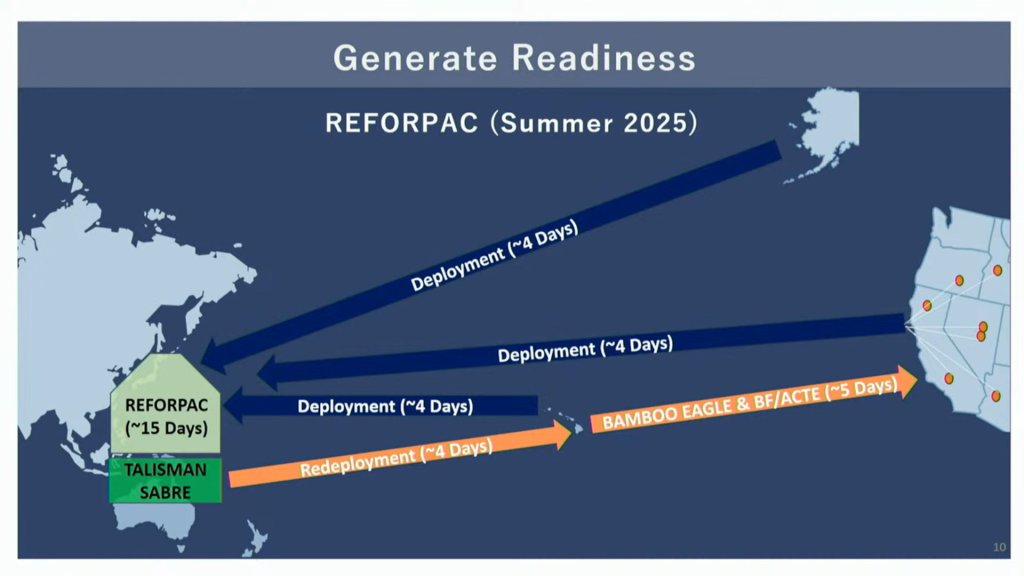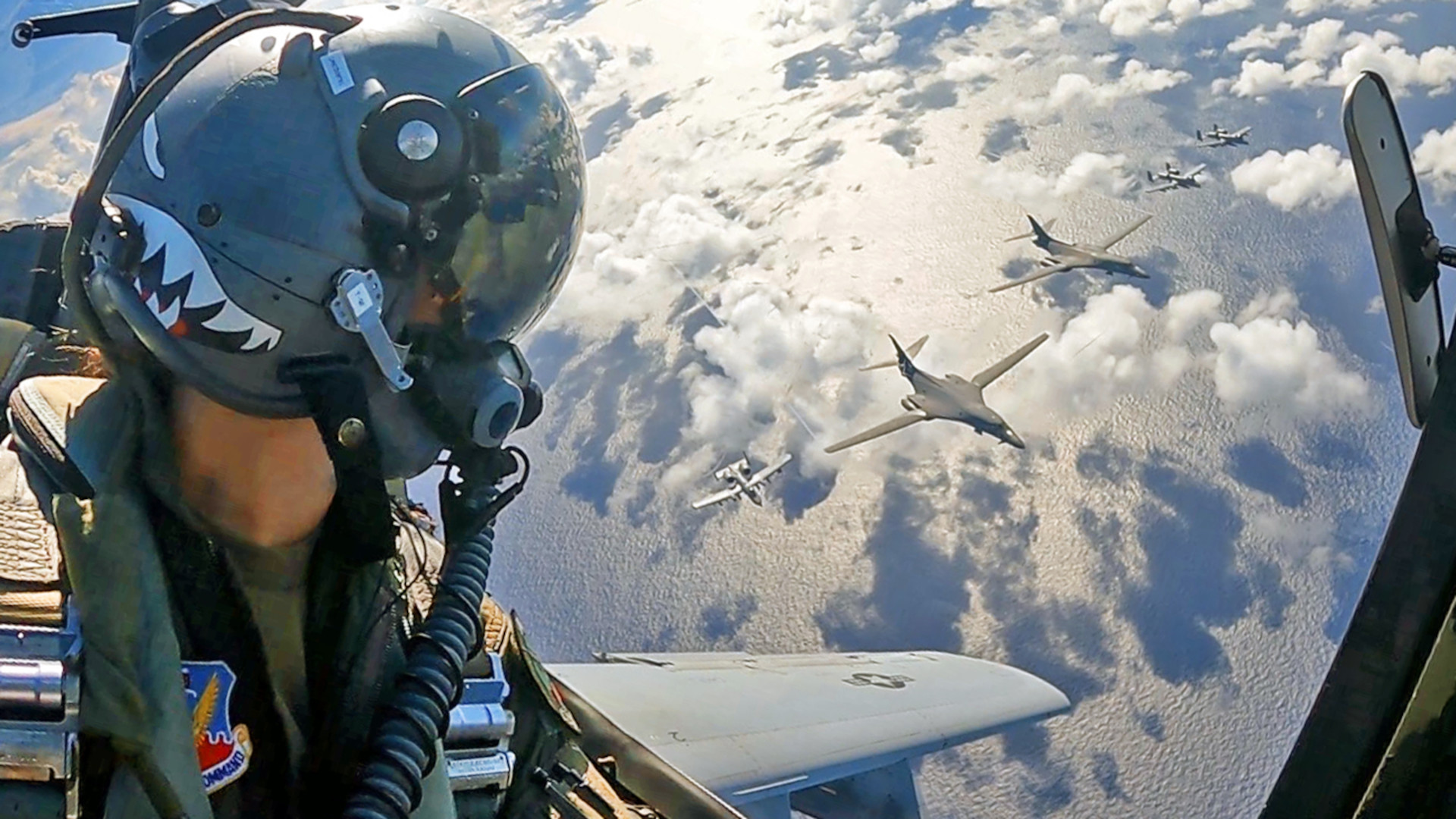Next summer, U.S. Air Force units will deploy from bases in Alaska, Hawaii, Guam, and elsewhere across the United States to forward locations in the Western Pacific as part of a massive new air combat exercise. REFORPAC will give the service a unique opportunity to test out still-evolving concepts for how to get large forces relatively quickly to far-flung locales and force structure changes to make units more readily deployable. The Air Force sees these developments as critical to succeeding in a future high-end fight in the Pacific, particularly one against China.

Gen. David Allvin, chief of staff of the Air Force, provided details about REFORPAC and related developments at a talk the Hudson Institute think tank hosted last Friday. Air Force officials had mentioned this forthcoming exercise in the past, but had provided few specific details.
“So, we will be deploying from Alaska, Hawaii, Guam, [and] the continental United States, and it’s going to be for about 14 days overall,” Allvin explained. “We’re integrating it into INDOPACOM’s [U.S. Indo-Pacific Command] campaign plans and our Pacific Air Forces‘ approach to supporting those [plans]. And so we’re integrating it into the combatant commanders piece, but we’re doing it in a way that’s more robust, and it’s for a longer period of time.”

How many units, aircraft, and personnel will be involved in REFORPAC, as well as where they will be deploying is unclear. During his talk, Allvin shared a map, seen above, suggesting the exercise area will be in a zone roughly between Japan and the Philippines. The map also says that it will take approximately four days for forces to get where they’re going in the first place. REFORPAC will also be tied in on some level with the biennial Talisman Sabre exercise in Australia.
Allvin noted that the Air Force has already been working to increase the scale and scope of large force air combat and air mobility exercises in and around the continental United States.

“We need to get back to those large scale exercises, and to their credit, many of the wing level, and the numbered air force level, and even some of the MAJCOM [major command] level [units], they have started to organically expand their exercises,” the Air Force’s top officer explained. “Red Flag exercises have become more expansive. The Weapon School integration [exercises], their sort of culminating events, are becoming more combat representative and expanding.”
This is a trend that The War Zone has been following closely and is particularly typified by the new Pacific-focused Bamboo Eagle exercise series, the latest iteration of which just wrapped up recently at bases across California. Another major component of Bamboo Eagle has been validating the Air Force’s new Air Combat Employment (ACE) concepts of operations, which are centered on deploying forces to disparate forward locations in unpredictable and irregular ways to upend an enemy’s targeting cycle and reduce vulnerability. Per the map that Gen. Allvin shared last week, at least some units returning from REFORPAC and/or Talisman Sabre will then head to another iteration of Bamboo Eagle.

“Problem is, [the] fight won’t be on if we can’t get there. And we need to recognize that and appreciate that. And so [Exercise] Mobility Guardian is starting to have us understand those complexities,” Gen. Allvin continued. “[But] you don’t really know – you can part task train this, but until you’re there, doing it over a period of time, you’re not really going to uncover the warts that you might not have discovered by doing it in pieces. You have to do it in a realistic scenario.”
That’s where REFORPAC comes in. The exercise’s name is a deliberate reference to the late Cold War-era Return of Forces to Germany (REFORGER) exercises. Each iteration of REFORGER was designed to demonstrate the ability of the U.S. military and the rest of NATO to relatively rapidly deploy large numbers of personnel and materiel to Germany in the event of a conflict with Warsaw Pact states.
In addition to highlighting what the Air Force is working to achieve with ACE, REFORPAC also underscores how the service is looking to restructure itself to support those concepts of operations. In February, secretary of the Air Force Frank Kendall unveiled plans for sweeping force structure changes, including the creation of so-called deployable combat wings (DCW). DCWs will be designed to be capable of deploying forward as cohesive entities and slotting right into regional command and control structures.
Another graphic which Gen. Allvin shared during his talk last week, seen below, depicted DCWs deploying to centralized locations in the Pacific and Europe before dispensing to tertiary locations.

“This is where we’re transitioning to in our projecting power in great power competition is having deployable combat wings,” Allvin said. “Back to the unit equipped with everything it needs to pick up and go and command and control a different way, into a contested environment, into an environment where you may be under threat, you may be under fire.”
REFORPAC will also offer important opportunities to test new and improved ‘kill chain’ architectures and the networking capabilities that underpin them across distances with forces spread across a broad area.
Questions remain about the Air Force’s ability to rapidly pack up units, especially in larger numbers, and get them down range relatively quickly. As Gen. Allvin alluded to in his talk by mentioning lessons already learned from iterations of the Mobility Guardian exercise, the service has long-standing concerns about the capacity of its current airlift and aerial refueling fleets to meet existing operational demands, let alone what would be required to support a sustained high-end fight.

On top of that, as already noted, the map Allvin showed during his talk on Friday shows that it will take days for all the units heading to REFORGER to get into place. Those movements also look set to involve transits via large established bases in places like Guam and Hawaii that are expected to be prime targets in any future major conflict in the Pacific – the exact issues that prompted the Air Force to develop ACE to begin with.
The need for more and better base defenses, and how best to meet those needs, is now a hot topic of discussion within the U.S. military, as well as between the services and Congress. An especially pointed debate has emerged over the value of investing in new passive defenses like hardened aircraft shelters.

“We are investing in shelters, and we are investing in looking [at] how we get back to doing camouflage, concealment, and deception, as well. But what I’d offer is we’re thinking about it, I think, [in] a different way than we were 30-40, years ago, because of the sophistication of the surveillance that’s available, whether by satellite or other means,” Allvin explained in response to a question about base defenses. “We have to be very sophisticated in our decoys, if you will. I mean, you can’t just put [up] an inflatable F-35 and say, ‘Guess what? Everybody’s gonna think it’s an F-35.'”
You can read more about what is known about the Air Force’s efforts to expand and improve its capabilities in this past War Zone feature.
“When you think of how advanced algorithms are, you need to be pretty sophisticated, otherwise that money will be worthless because the adversary will go, they’ll discount it immediately,” Allvin continued. “How do you mimic pattern of life? How do you mimic a signature? And so we’re looking at all those ways to ensure that the things that we are doing are actually appropriate for the time.”

Base defense concerns extend well beyond the Western Pacific, too. Air Force and other U.S. military officials have repeatedly warned that China, in particular, could contest American forces all the way back to the homeland in a high-end fight.
“We need to ensure that those airbase wings [that are left behind when DCWs deploy] that are managing the wing are still viable. Because, guess what, if we think we’re going to be in an era of great power competition and could be in a conflict, we need to understand that even our home bases are not going to be sanctuaries,” Allvin himself said last week. “Those base commanders need to know how to fight cyber attacks, power disruptions, [and] counter small UASs. Those are the things that the adversary, a thinking adversary, will try to attack to keep us from continuing to generate power and projecting it into theater.”
With all this in mind, REFORPAC looks set to be a seminal event for an Air Force that is already making major changes to how it plans to fight in the future, especially in the Pacific against China.
Contact the author: joe@twz.com
